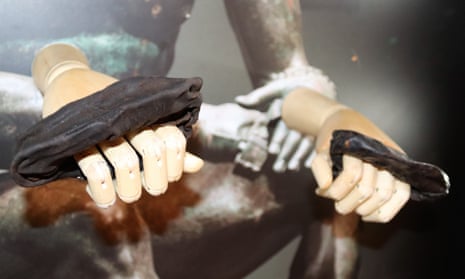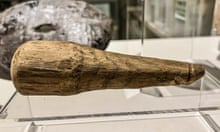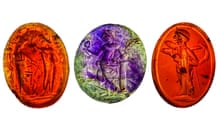Roman boxing gloves have been discovered near Hadrian’s Wall, thought to be the only known surviving examples, even though the sport was well- documented on Roman wall paintings, mosaics and sculptures.
With a protective guard designed to fit snugly over the knuckles, the gloves were packed with natural material which acted as shock absorbers. They date from around AD120 and were certainly made to last: they still fit comfortably on a modern hand. One of them even retains the impression of the knuckles of its ancient wearer.
They are among the latest discoveries at a pre-Hadrianic Roman cavalry barrack, which was found last year beneath the fourth-century stone fort of Vindolanda, south of Hadrian’s Wall near Hexham, Northumberland.
Dr Andrew Birley, the Vindolanda Trust’s director of excavations, said: “The hairs stand up on the back of your neck when you realise that you have discovered something as astonishing as these boxing gloves.”
Archaeologists stumbled across the site by chance and were taken aback by extraordinary military and personal possessions left behind by the men and their families some 2,000 years ago. Other finds include complete swords, which are exceptionally rare, even across the north-west provinces of the Roman empire.
The finds are in a remarkable state of preservation because they were concealed beneath a concrete floor laid by the Romans about 30 years after the barracks was abandoned, shortly before 120. Oxygen-free conditions prevented materials such as wood and leather from decaying.

The gloves, resembling leather padded bands rather than the full-hand boxing gloves used today, are similar in style and function, although are not a matching pair.
Patricia Birley, the trust’s former director who has researched the gloves, said: “To the best of our knowledge, no examples have ever been found in the Roman empire.
“It’s always tremendously exciting when you find something that you know about through other sources – depictions on wall paintings, vases … but to see the real thing is something quite unique. You learn so much more … For example, the larger of the gloves has been repaired. The owner has really wanted to keep this thing going, so he’s done his utmost to repair it and patch it. It’s that human touch that you get through the real object.”
She noted there were extensive ancient writings about boxing – “quite a bit from the Greek side and then the Romans took it to a different level”.
The ancient Greek philosopher Plato wrote: “Surely, if we were boxers, we should have been learning to fight for many days before, and exercising ourselves in imitating all those blows and wards which we were intending to use in the hour of conflict; and in order that we might come as near to reality as possible, instead of cestuses [leather straps, often weighted with metal] we should put on boxing gloves.”
In the Roman army, boxing was practised to promote fighting skills and fitness, and included competitions with spectators. The gloves will be among finds from the barracks displayed at the Vindolanda site museum from Tuesday. Excavations resume in April.









